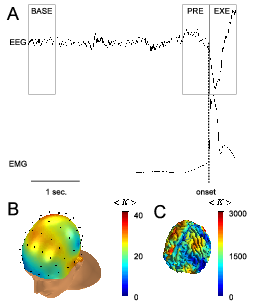Section: New Results
Accessibility of cortical networks during motor tasks
Participants : Mario Chavez [Correspondant] , Fabrizio de Vico Fallani, Miguel Valencia, Mario Chavez, Julio Artieda, Vito Latora, Donatella Mattia, Fabio Babiloni.
Recent findings suggest that the preparation and execution of voluntary self-paced movements are accompanied by the coordination of the oscillatory activities of distributed brain regions. We used electroencephalographic source imaging methods to estimate the cortical movement-related oscillatory activity during finger ex- tension movements. We applied network theory to investigate changes (expressed as differences from the baseline) in the connectivity structure of cortical networks related to the preparation and execution of the movement. We computed the topological accessibility of different cortical areas, measuring how well an area can be reached by the rest of the network. Analysis of cortical networks revealed specific agglomerates of cortical sources that become less accessible during the preparation and the execution of the finger movements. The observed changes neither could be explained by other measures based on geodesics or on multiple paths, nor by power changes in the cortical oscillations.
|
Related publication: [3]



